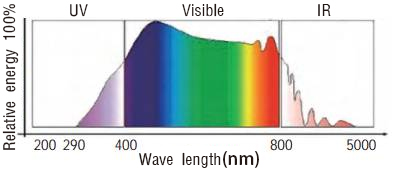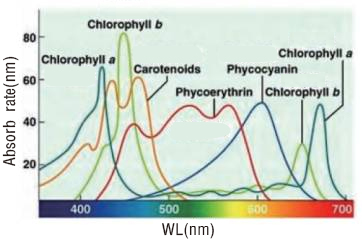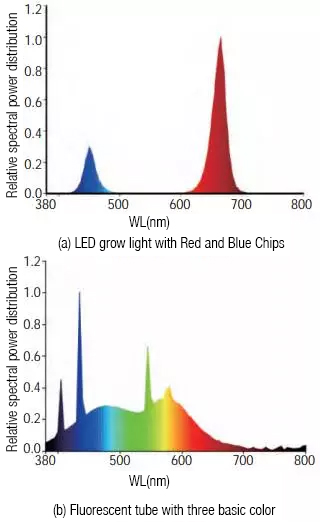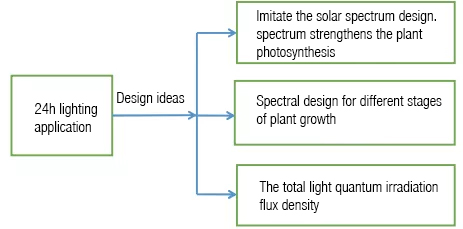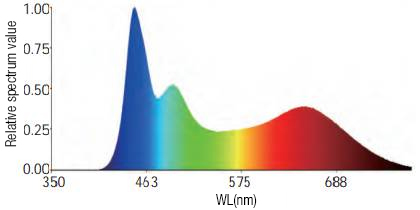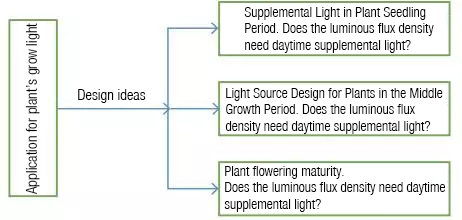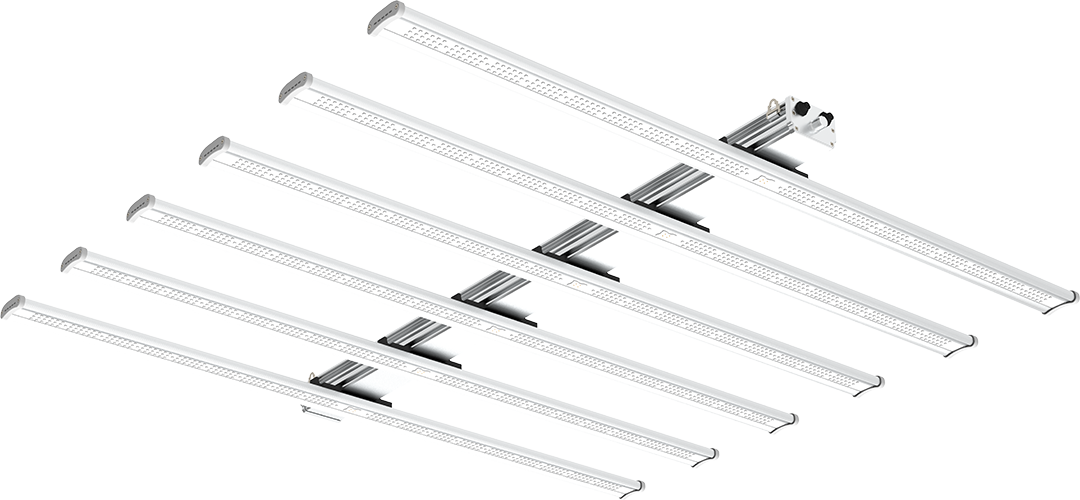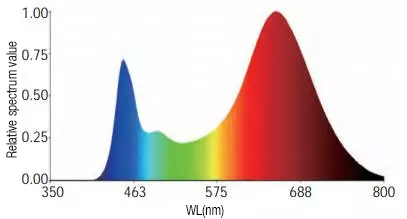Introduction
Light plays a key role in the process of plant growth. It is the best fertilizer to promote the absorption of plant chlorophyll and the absorption of various plant growth qualities such as carotene. However, the decisive factor that determines the growth of plants is a comprehensive factor, not only related to light, but also inseparable from the configuration of water, soil and fertilizer, growth environment conditions and comprehensive technical control.
In the past two or three years, there have been endless reports on the application of semiconductor lighting technology regarding three-dimensional plant factories or plant growth. But after reading it carefully, there is always some uneasy feeling. Generally speaking, there is no real understanding of what role light should play in plant growth.
First, let’s understand the spectrum of the sun, as shown in Figure 1. It can be seen that the solar spectrum is a continuous spectrum, in which the blue and green spectrum are stronger than the red spectrum, and the visible light spectrum ranges from 380 to 780 nm. The growth of organisms in nature is related to the intensity of the spectrum. For example, most plants in the area near the equator grow very fast, and at the same time, the size of their growth is relatively large. But the high intensity of the sun’s irradiation isn’t always the better, and there is a certain degree of selectivity for the growth of animals and plants.
Figure 1, The characteristics of the solar spectrum and its visible light spectrum
Secondly, the second spectrum diagram of several key absorption elements of plant growth is shown in Figure 2.
Figure 2, Absorption spectra of several auxins in plant growth
It can be seen from Figure 2 that the light absorption spectra of several key auxins that affect plant growth are significantly different. Therefore, the application of LED plant growth lights is not a simple matter, but very targeted. Here it is necessary to introduce the concepts of the two most important photosynthetic plant growth elements.
• Chlorophyll
Chlorophyll is one of the most important pigments related to photosynthesis. It exists in all organisms that can create photosynthesis, including green plants, prokaryotic blue-green algae (cyanobacteria) and eukaryotic algae. Chlorophyll absorbs energy from light, which is then used to convert carbon dioxide into carbohydrates.
Chlorophyll a mainly absorbs red light, and chlorophyll b mainly absorbs blue-violet light, mainly to distinguish shade plants from sun plants. The ratio of chlorophyll b to chlorophyll a of shade plants is small, so shade plants can use blue light strongly and adapt to growing in shade. Chlorophyll a is blue-green, and chlorophyll b is yellow-green. There are two strong absorptions of chlorophyll a and chlorophyll b, one in the red region with a wavelength of 630-680 nm, and the other in the blue-violet region with a wavelength of 400-460 nm.
• Carotenoids
Carotenoids are the general term for a class of important natural pigments, which are commonly found in yellow, orange-red or red pigments in animals, higher plants, fungi, and algae. So far, more than 600 natural carotenoids have been discovered.
The light absorption of carotenoids covers the range of OD303~505 nm, which provides the color of food and affects the body’s intake of food. In algae, plants, and microorganisms, its color is covered by chlorophyll and cannot appear. In plant cells, the carotenoids produced not only absorb and transfer energy to help photosynthesis, but also have the function of protecting cells from being destroyed by excited single-electron bond oxygen molecules.
Some conceptual misunderstandings
Regardless of the energy-saving effect, the selectivity of light and the coordination of light, semiconductor lighting has shown great advantages. However, from the rapid development of the past two years, we have also seen a lot of misunderstandings in the design and application of light, which are mainly reflected in the following aspects.
①As long as the red and blue chips of a certain wavelength are combined in a certain ratio, they can be used in plant cultivation, for example, the ratio of red to blue is 4:1, 6:1, 9:1 and so on.
②As long as it is white light, it can replace the sun’s light, such as the three-primary white light tube widely used in Japan, etc. The use of these spectrums has a certain effect on the growth of plants, but the effect is not as good as the light source made by LED.
③As long as the PPFD (light quantum flux density), an important parameter of illumination, reaches a certain index, for example, PPFD is greater than 200 μmol·m-2·s-1. However, when using this indicator, you must pay attention to whether it is a shade plant or a sun plant. You need to query or find the light compensation saturation point of these plants, which is also called the light compensation point. In actual applications, seedlings are often burned or withered. Therefore, the design of this parameter must be designed according to the plant species, growth environment and conditions.
Regarding the first aspect, as introduced in the introduction, the spectrum required for plant growth should be a continuous spectrum with a certain distribution width. It is obviously inappropriate to use a light source made of two specific wavelength chips of red and blue with a very narrow spectrum (as shown in Figure 3(a)). In experiments, it was found that plants tend to be yellowish, the leaf stems are very light, and the leaf stems are very thin.
For fluorescent tubes with three primary colors commonly used in previous years, although white is synthesized, the red, green, and blue spectra are separated (as shown in Figure 3(b)), and the width of the spectrum is very narrow. The spectral intensity of the following continuous part is relatively weak, and the power is still relatively large compared to LEDs, 1.5 to 3 times the energy consumption. Therefore, the use effect is not as good as LED lights.
Figure 3, Red and blue chip LED plant light and three-primary color fluorescent light spectrum
PPFD is the light quantum flux density, which refers to the effective radiation light flux density of light in photosynthesis, which represents the total number of light quanta incident on plant leaf stems in the wavelength range of 400 to 700 nm per unit time and unit area. Its unit is μE·m-2·s-1 (μmol·m-2·s-1). The photosynthetically active radiation (PAR) refers to the total solar radiation with a wavelength in the range of 400 to 700 nm. It can be expressed either by light quanta or by radiant energy.
In the past, the light intensity reflected by the illuminometer was brightness, but the spectrum of plant growth changes because of the height of the light fixture from the plant, the light coverage and whether the light can pass through the leaves. Therefore, it is not accurate to use par as an indicator of light intensity in the study of photosynthesis.
Generally, the photosynthesis mechanism can be initiated when the PPFD of the sun-loving plant is bigger than 50 μmol·m-2·s-1, while the PPFD of the shady plant only needs 20 μmol·m-2·s-1. Therefore, when purchasing LED grow lights, you can choose the number of LED grow lights based on this reference value and the type of plants you plant. For example, if the PPFD of a single LED lght is 20 μmol·m-2·s-1, more than 3 LED plant bulbs are required to grow sun-loving plants.
Several design solutions of semiconductor lighting
Semiconductor lighting is used for plant growth or planting, and there are two basic reference methods.
• At present, the indoor planting model is very hot in China. This model has several characteristics:
①The role of LED lights is to provide the full spectrum of plant lighting, and the lighting system is required to provide all the lighting energy, and the production cost is relatively high;
②The design of LED grow lights needs to consider the continuity and integrity of the spectrum;
③It is necessary to effectively control the lighting time and lighting intensity, such as letting the plants rest for a few hours, the intensity of the irradiation is not enough or too strong, etc.;
④The whole process needs to imitate the conditions required by the actual optimal growth environment of plants outdoors, such as humidity, temperature and CO2 concentration.
• Outdoor planting mode with good outdoor greenhouse planting foundation. The characteristics of this model are:
①The role of LED lights is to supplement light. One is to enhance the light intensity in the blue and red areas under the irradiation of sunlight during the day to promote photosynthesis of plants, and the other is to compensate when there is no sunlight at night to promote Plant growth rate
②The supplementary light needs to consider which growth stage the plant is in, such as the seedling period or the flowering and fruiting period.
Therefore, the design of LED plant grow lights should first have two basic design modes, namely, 24h lighting (indoor) and plant growth supplement lighting (outdoor). For indoor plant cultivation, the design of LED grow lights needs to consider three aspects, as shown in Figure 4. It is not possible to package the chips with three primary colors in a certain proportion.
Figure 4, The design idea of using indoor LED plant booster lights for 24h lighting
For example, for a spectrum in the nursery stage, considering that it needs to strengthen the growth of roots and stems, strengthen the branching of leaves, and the light source is used indoors, the spectrum can be designed as shown in Figure 5.
Figure 5, Spectral structures suitable for LED indoor nursery period
For the design of the second type of LED grow light, it is mainly aimed at the design solution of supplementing light to promote the planting in the base of outdoor greenhouse. The design idea is shown in Figure 6.
Figure 6, Design ideas of outdoor grow lights
The author suggests that more planting companies adopt the second option to use LED lights to promote plant growth.
First of all, China’s outdoor greenhouse cultivation has decades a large amount and a wide range of experience, both in the south and the north. It has a good foundation of greenhouse cultivation technology and provides a large number of fresh fruits and vegetables on the market for surrounding cities. Especially in the field of soil and water and fertilizer planting, rich research results have been made.
Secondly, this kind of supplemental light solution can greatly reduce unnecessary consumption of energy, and at the same time can effectively increase the yield of fruits and vegetables. In addition, China’s vast geographical area is very convenient for promotion.
As the scientific research of LED plant lighting, it also provides a broader experimental base for it. Fig. 7 is a kind of LED grow light developed by this research team, which is suitable for growing in greenhouses, and its spectrum is shown in Fig. 8.
Figure 7, A kind of LED grow light
Figure 8, spectrum of a kind of LED grow light
According to the above design ideas, the research team conducted a series of experiments, and the experimental results are very significant. For example, for grow light during nursery, the original lamp used is a fluorescent lamp with a power of 32 W and a nursery cycle of 40 days. We provide a 12 W LED light, which shortens the seedling cycle to 30 days, effectively reduces the influence of the temperature of the lamps in the seedling workshop, and saves the power consumption of the air conditioner. The thickness, length and color of the seedlings are better than the original seedling raising solution. For the seedlings of common vegetables, good verification conclusions have also been obtained, which are summarized in the following table.
Among them, the supplementary light group PPFD: 70-80 μmol·m-2·s-1, and the red-blue ratio: 0.6-0.7. The range of daytime PPFD value of the natural group was 40~800 μmol·m-2·s-1, and the ratio of red to blue was 0.6~1.2. It can be seen that the above indicators are better than those of naturally grown seedlings.
Conclusion
This article introduces the latest developments in the application of LED grow lights in plant cultivation, and points out some misunderstandings in the application of LED grow light in plant cultivation. Finally, the technical ideas and schemes for the development of LED grow lights used for plant cultivation are introduced. It should be pointed out that there are also some factors that need to be considered in the installation and use of the light, such as the distance between the light and the plant, the irradiation range of the lamp, and how to apply the light with normal water, fertilizer, and soil.
Author: Yi Wang et al. Source: CNKI
Post time: Oct-08-2021


